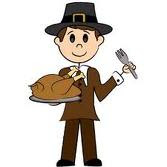
Last year at about this time I posted The Puerto Rican Thanksgiving Turkey. Our version of the holiday bird. I noted that we spice it differently and make it more flavorful so that it tastes like roasted pork, or pernil, the main holiday staple back on the island in the days of yore.
Here it is again, turkey a la criolla (creole style). A note on the term “Boricua.” A Boricua (bo-ree-kuah) is an inhabitant of the island of Borinquen, the native Taino Indian name for Puerto Rico. Hence a Boricua is a native born Puerto Rican. However, these days we take the term to mean anyone of Puerto Rican descent, whether they were born on the island or not.
PAVO RELLENO A LA CRIOLLA
(Stuffed Roast Turkey)
1 8 1/2-pound dressed-weight turkey
5 cloves garlic, peeled
6 whole black peppercorns
1 tablespoon dried oregano
4 teaspoons salt
1 cup olive oil
4 tablespoons paprika
1/4 cup vinegar
3 tablespoons vegetable oil
1 1/2-pounds lean ground beef
1 packet sason accent (Goya makes a good one with coriander and annatto)
1/2 cup stuffed Spanish olives
4 tablespoons capers
1/2 cup tomato sauce
1. Rinse and wash turkey, inside and out, and wipe dry. Do the same with the heart, liver and gizzard, and then chop innards coarsely. This will be combined with the ground beef when preparing the stuffing.
2. Pound together the garlic, peppercorns, oregano and 3 teaspoons salt in a mortar. Add 1/2 cup olive oil, 2 tablespoons paprika, vinegar and combine. Rub the turkey with the seasoning inside and out—what my mother calls “adobar el pavo” (seasoning the beast). This should be done a day ahead (the turkey should be left overnight, in a covered pot, in the refrigerator). This will allow it to absorb the flavors.
3. Heat vegetable oil in a frying pan or skillet. Add the ground beef and cook over high heat, stirring frequently, until the meat loses its color. Reduce heat to medium-low and stir in the sason accent, olives, capers, tomato sauce and remaining teaspoon salt. Cook for 20 minutes, stirring occasionally to complete cooking the stuffing.
4. Remove from heat and let cool. Stuff the turkey loosely about three quarters full. Truss the turkey (sew or skewer together the neck and bind the legs.)
5. Place the turkey in a roasting pan breast side down. To insure a golden brown exterior combine the remaining 2 tablespoons paprika with the remaining olive oil in a small bowl. Brush the entire turkey with this mixture and roast in a slow to moderate oven (325 degrees F.) for 3 1/2 hours. To brown bird, raise temperature to 350 degrees during the last 25 minutes of cooking. This is an excellent way of cooking if in doubt as to the tenderness of the meat. Some people prefer covering the turkey with aluminum foil while roasting, and removing this during the last 25-30 minutes of cooking time to brown the skin. I find that frequent basting during cooking gets the same results.
Baking theories abound. There is the old traditionalist view that allows 1 1/2 hours for the first pound and then 25 minutes per pound up to 7 pounds and 20 minutes per pound after that. Thus a 5 pound bird would take 3 hours and 10 minutes, a 7 pounder would take 4 hours and 10 minutes, and a 10 pound bird 5 hours and 10 minutes. But in my view, there’s no set rule. Some birds take more time to roast, some less. In the Rivera family we go by general common sense: figure a 7 to 8 pounder takes 3 1/2 to 4 hours to cook; a 10 pounder maybe 4 1/2 hours, and a 12 pound turkey maybe 5-5 1/2 hours. Rule of thumb: turkey is done when drumstick and thigh move easily.
6. For gravy: remove turkey from roasting pan and keep warm. Drain drippings from roasting pan into a sauce pan. Skim off fat but retain 1/4 cup of the drippings. Add 2 cups water or 1/2 cup dry white wine and 1 1/2 cups water to pan drippings. Bring to a boil over high heat while stirring in the 1/4 cup fat. Lower heat and thicken slightly with a little cornstarch and water combined. If you want to reduce the grease content, mix 3 teaspoons of cornstarch with 3 tablespoons of water. Add this to the strained pan drippings and heat, thereby omitting the remaining fat content.
Yield: 6 to 7 servings.
Note: serve with a light Valpolicella wine, lightly chilled; a full-bodied red such as a Zinfandel or Rioja; a white Burgundy with a full and flowery bouquet; or even a good-bodied ale.

Leave a Reply